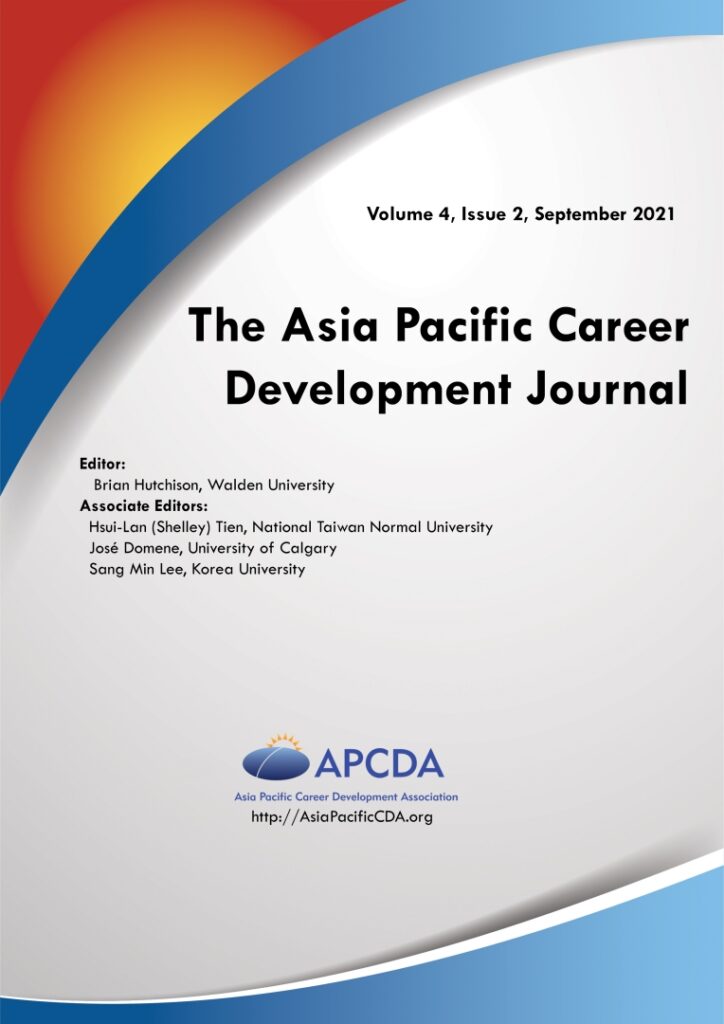The Asia Pacific Career Development Journal, Vol 4. No 2
Vol 4 No 2 (2021): September 2021 Issue
Published: 2021-09-19

Abstract: This issue marks the beginning of the fourth year of publication for the Asia Pacific Career Development Journal. Starting a journal is no small feat; sustaining one is even more difficult. I want to use this Editor’s Note to reflect on our journal’s purpose, past, and future before ending with some ways that you can help support this important enterprise.
Lead Article
Hongshan Shao
Abstract: The number of international students in the United States is on the rise. China is the largest home country of international students in the United States. However, there was little research that pertains to Chinese international students’ experiences in the U.S. with career counseling services. Using a Contextual Action Theory model of culturally sensitive career practice (Young et al., 2007), this article aimed to address the unique career development needs and challenges faced by Chinese international students. As a global crisis, the COVID-19 has also brought extra challenges for Chinese international students. This article provided applications for career counselors and professionals to help this population navigate career choice and decision-making. Implications for research, career counseling, and career services professionals were addressed as well.
Emprical Articles
Amberyce Ang and Kalyani Mehta
Abstract: This study examines the motivations behind bridge employment for retirees, the meaning of extended work life to retirees and retirees’ desired bridge employment. This study shows that older adults who have involuntary retirement are more likely than older adults who had voluntary retirement, to desire bridge employment. The data suggests that retirees are primarily motivated by the social interactions in bridge employment, rather than financial rewards. Extended work life through bridge employment is viewed by retirees as a productive use of time and yet allowing them to balance between “self and work”, and “self and others”. To the retiree, bridge employment increases self-esteem because being able to secure a job after retirement meant that the individual is still competent and wanted by the economy. Bridge employment also serves as a coping mechanism for retirement transitions. Participants who have involuntary retirement desire bridge employment more than participants who have voluntary retirement. They want to stay in touch with the working world and are not ready to entirely fade into the retirees’ world. They view the retirees’ world as one that is redundant and undesired by society and the economy. Regardless of retirement type, retirees who desire bridge employment prefer work that is less stressful and are willing to accept massive pay reduction to work on a part-time basis.
Review Articles
Andrew M. H. Tong and Mantak Yuen
Abstract: This article reports findings from a small-scale exploratory study in Hong Kong investigating female secondary school students’ experiences of, beliefs about, and attitudes towards career and life planning activities (CLP) in their school. Qualitative data obtained from focus group interviews with senior students were coded and analyzed to identify themes. Findings were interpreted in terms of students’ current opinions of the strengths, weaknesses, and overall value of CLP as delivered in the school. Students’ suggestions were obtained for how to strengthen CLP as a means of preparing them for the transition to adulthood and the world of work. Responses indicated that students felt their career-related decision-making and career adaptability could be improved by more frequent face-to-face counseling and the sharing of ideas, information, and concerns. The girls also suggested a need for more frequent opportunities for real career exploration and workplace experiences. Additionally, they felt that CLP would be strengthened by clearer intended outcomes from the learning activities, and better integration of some aspects of CLP into curriculum subjects. There was also a need for better continuity of the program from junior to senior secondary stages. These findings have practical implications for schools implementing CLP. Future studies should repeat the investigation in different types of school settings and could include the perceptions of teachers and parents.
The Asia Pacific Career Development Journal (APCDJ) is an international biannual publication dedicated to all career development and intervention related topics. It is the official journal of the Asia Pacific Career Development Association (APCDA;
